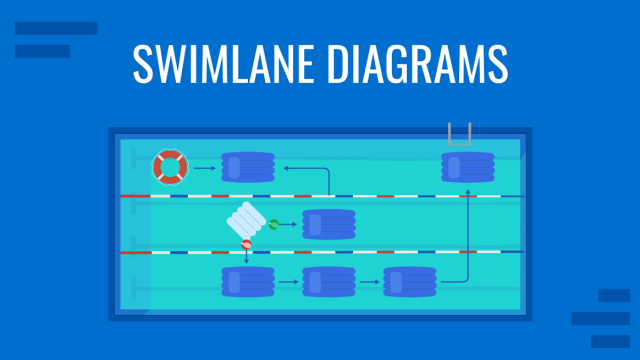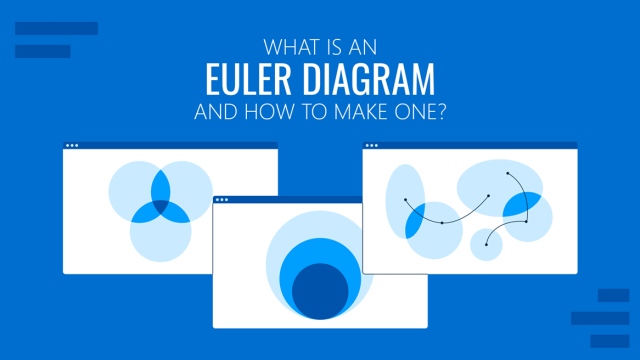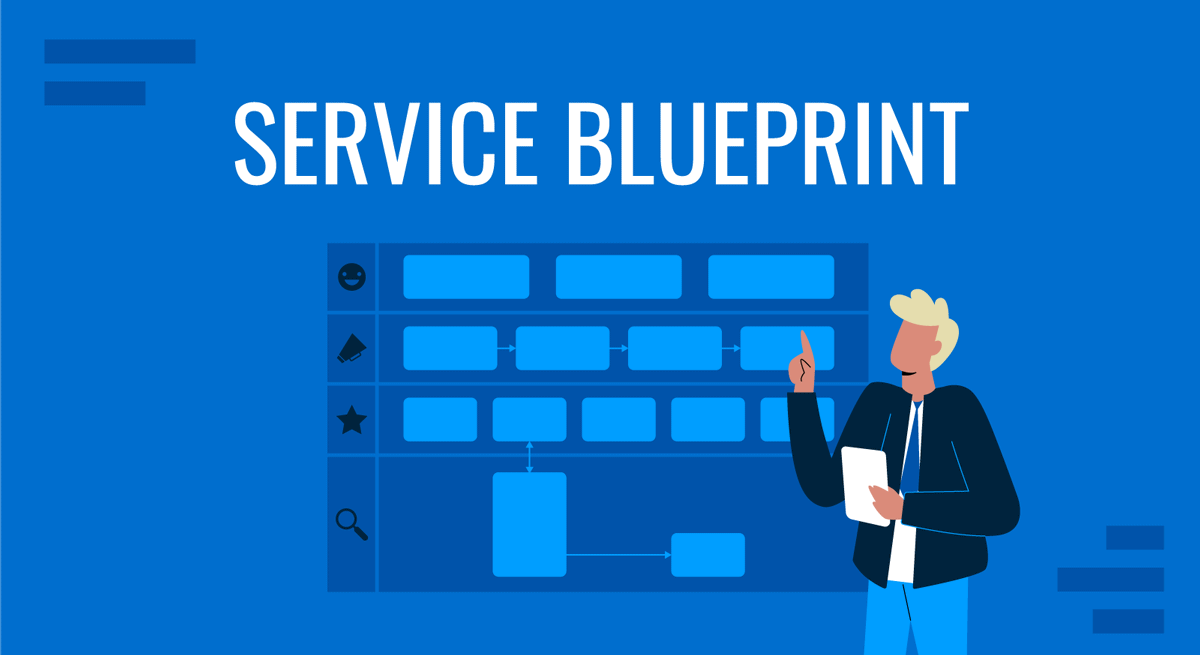
Maintaining high customer satisfaction and retention is more challenging nowadays. The explosion of digital services has given rise to several ways customers can come in contact with businesses. Although this is a huge blessing, it’s easy to get blindsided by many touchpoints to manage. And before you know it, your customers have already switched to your competitors.
To fully benefit from these multiple touchpoints, businesses must ensure they are providing a seamless service experience. Creating a seamless experience for customers involves understanding how a service or product is delivered from start to finish. This is where a service blueprint comes in.
In a nutshell, a service blueprint allows businesses to visualize the different steps involved in delivering a product or service, from the customer’s initial interaction with the business to the completion of the service.
If you are a service designer, this is for you. This article will discuss what goes into developing a service blueprint that drives business success.
Table of Contents
- What is a Service Blueprint?
- What does a Service Blueprint look like?
- Service Blueprints vs. Flowcharts
- Why do companies need a Service Blueprint?
- How to create a Service Blueprint
- Final Words
What is a Service Blueprint?
Service blueprinting is a method that maps out the entire customer journey and customer experience with a service, including every interaction, touchpoint, and operational activity involved in the delivery process. This graphic illustration helps companies understand the customer’s service experience, detect opportunities for enhancements, and streamline their services. To know more about your customers’ needs, you can conduct call center analytics and get insights from it. This is the process of collecting and analyzing call center data to improve customer experience, agent performance, customer service, and operational efficiency.
We can attribute the term “service blueprint” to G. Lynn Shostack, a pioneer in service design. In her 1982 Harvard Business Review article, she stressed the importance of focusing on the customer experience rather than just the operational process.
Shostack saw the service blueprint as a powerful tool for service design and innovation, stating that it “enables an organization to get inside the customer’s experience, see the service from the customer’s viewpoint, and design the service to be more effective and efficient.”
Service blueprinting has since become a widely-used tool for service design and improvement. It is commonly used in industries such as hospitality, healthcare, retail, and finance but can be applied to any service-based business.
What does a Service Blueprint look like?
Here’s a sample service blueprint for a hotel to give you a clear picture of it in action.
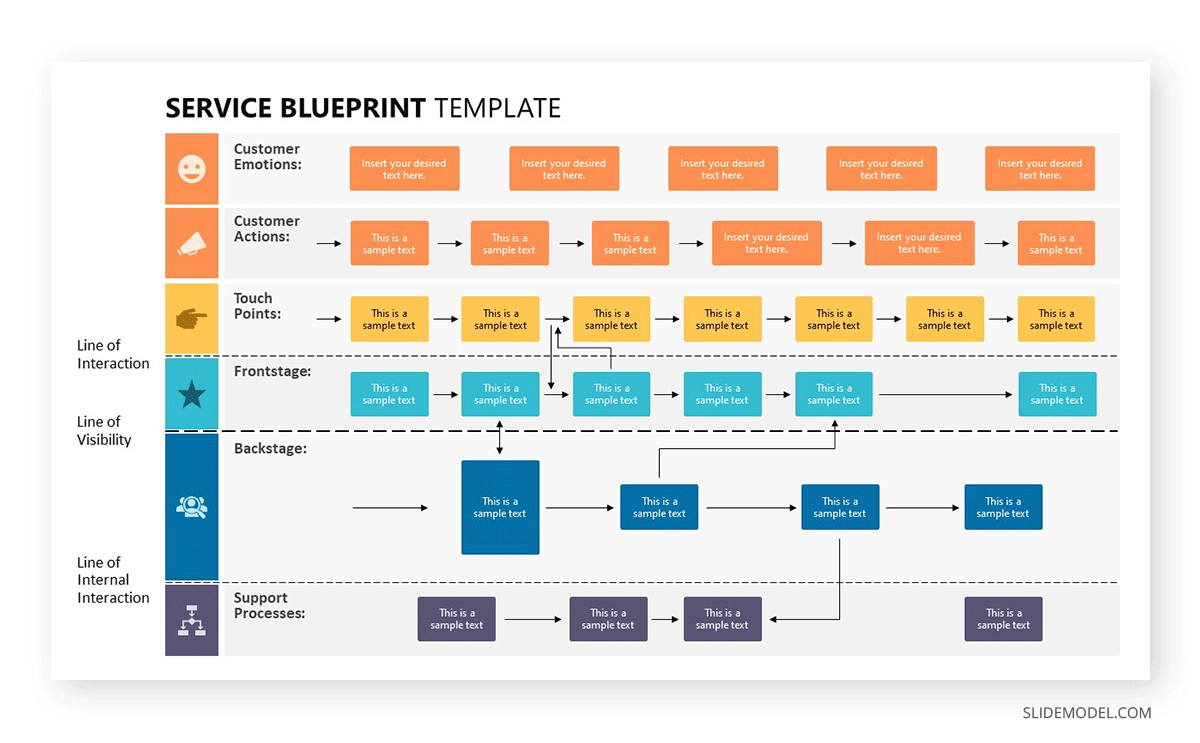
A service blueprint template typically includes several key components that help illustrate the service delivery process, such as customer actions, front-stage activities, back-stage activities, and support processes. These components are segregated using different lines based on their direct interaction and visibility for the customers.
Let’s break down the key elements and cluster a service blueprint includes.
Key Elements of a Service Blueprint
1. Customer Outcomes and Emotions. These refer to the perceived emotional responses and outcomes that customers experience during and after their service interaction. These outcomes can include positive emotions such as happiness, satisfaction, and loyalty or negative emotions such as frustration, disappointment, and anger.
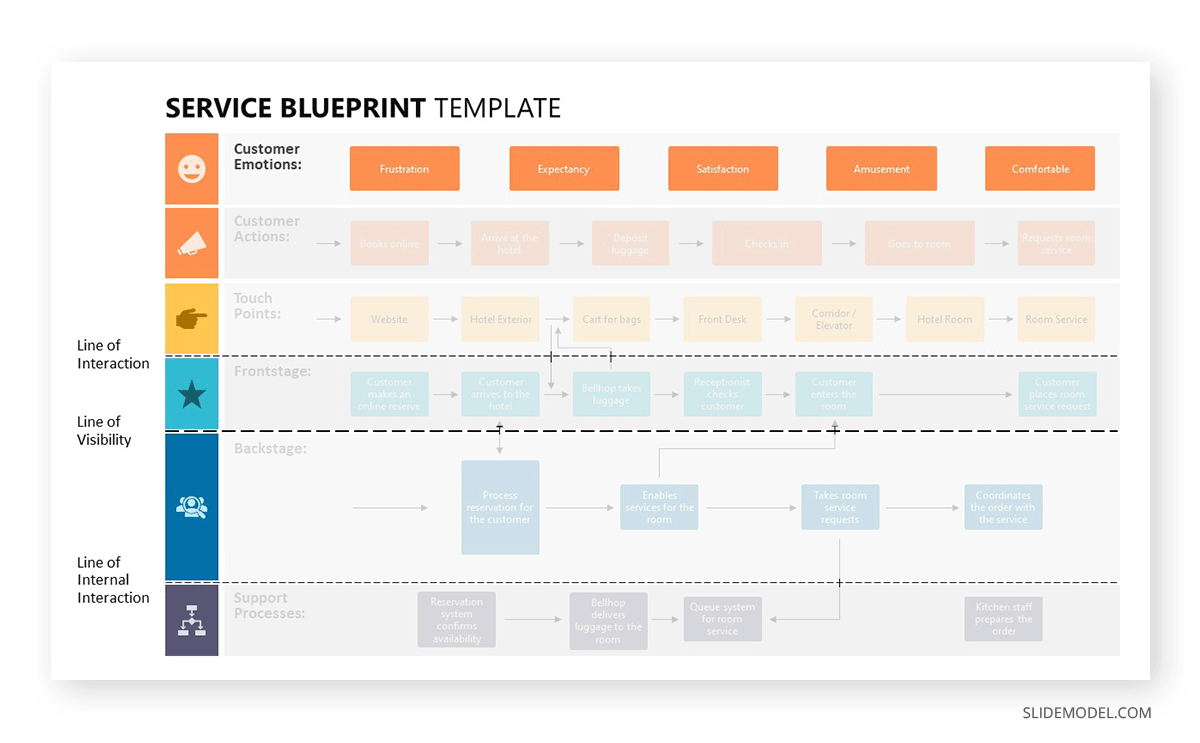
2. Props and Physical Evidence. These are the tangible components of a service that customers come into contact with during their service experience. These physical elements can influence the perception of the service quality and shape the customer’s overall experience.
In our service blueprint example, physical evidence includes amenities, branding throughout the hotel, room decor, etc.
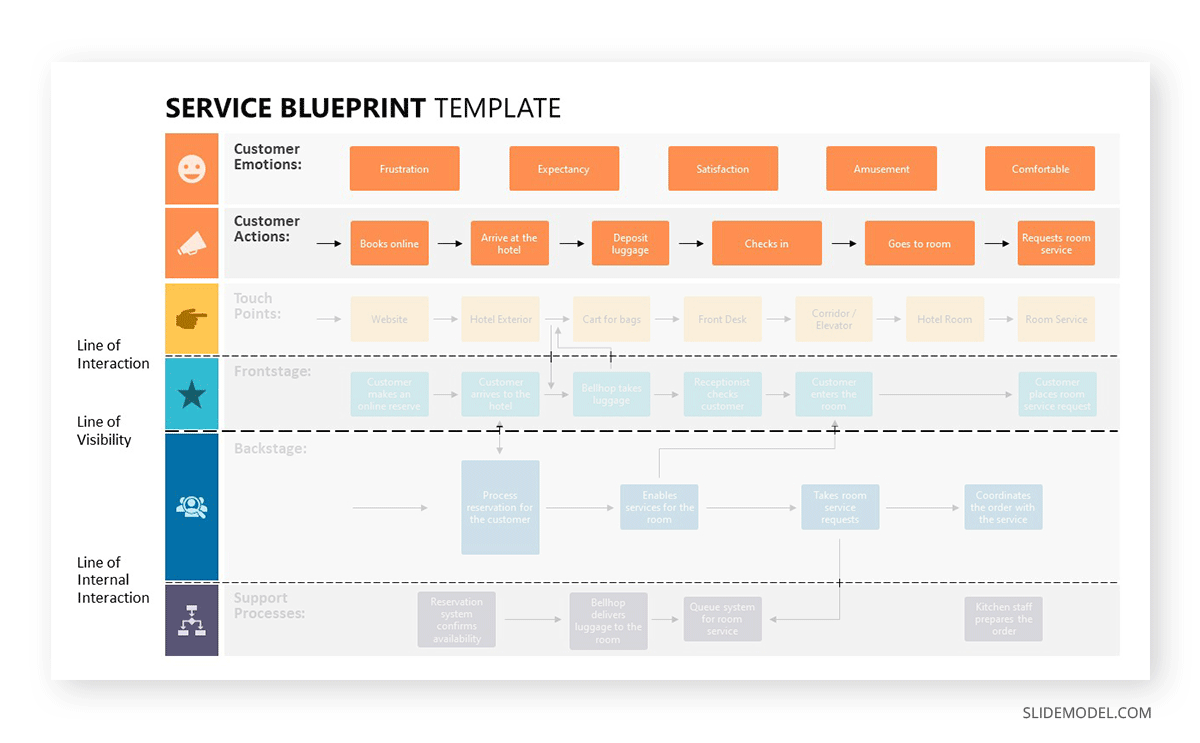
3. Customer Actions/ Journey. This represents the customer’s steps during the service process — basically, the customer journey.
In our blueprint sample, some of the actions a customer can take include booking a room online, arriving at the hotel, and checking in.
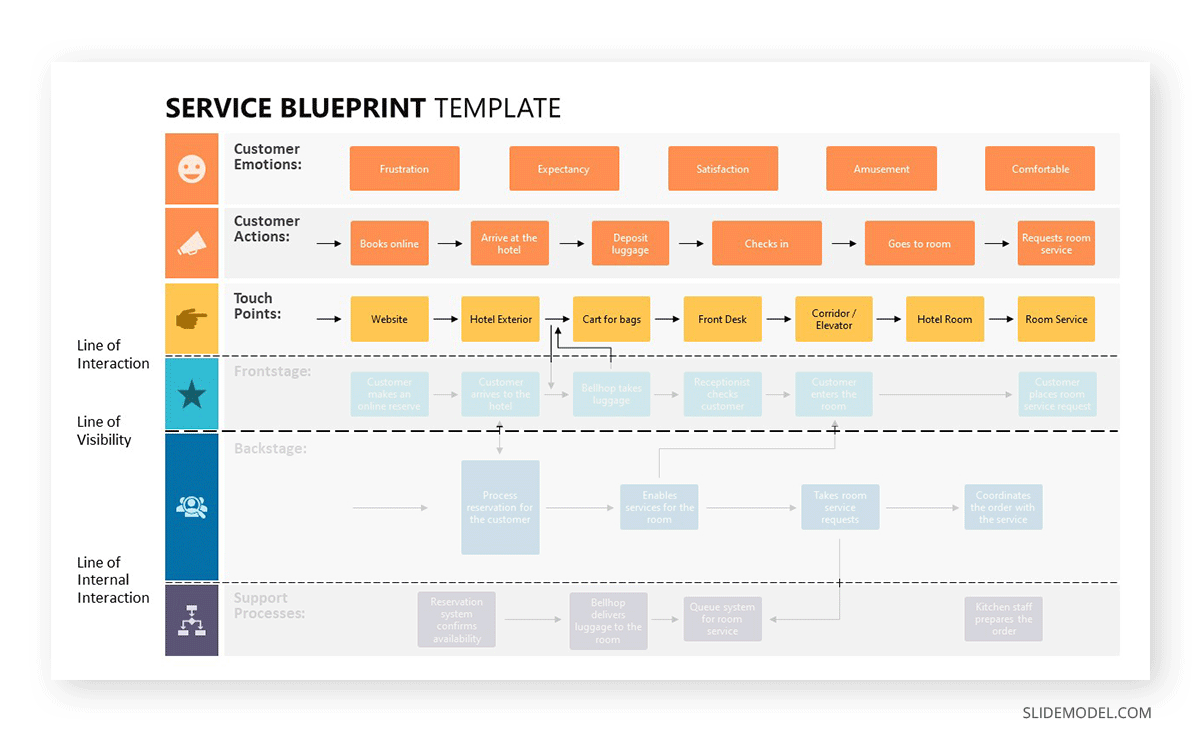
4. Front stage. The next row after the customer actions represents the front-stage activities, which are your business’s actions in your customer’s sight.
In our hotel example, the front stage may include the professional parking assistant, the front-desk officer greeting the customers, or the bellhop taking care of their luggage.

5. Backstage. This represents the actions that you, as the service provider, take behind the scenes to support the front-stage activities. These activities are not visible to the customer but are necessary to ensure the service is delivered successfully.
Some examples of backstage operations are the housekeeping staff preparing the hotel room and the kitchen staff overseeing the meals for room orders.

6. Supports Processes. The support processes represent the systems or resources that make it possible to deliver the service. Common examples of this element are the supply inventory management of a hotel, room database, and payment gateway.
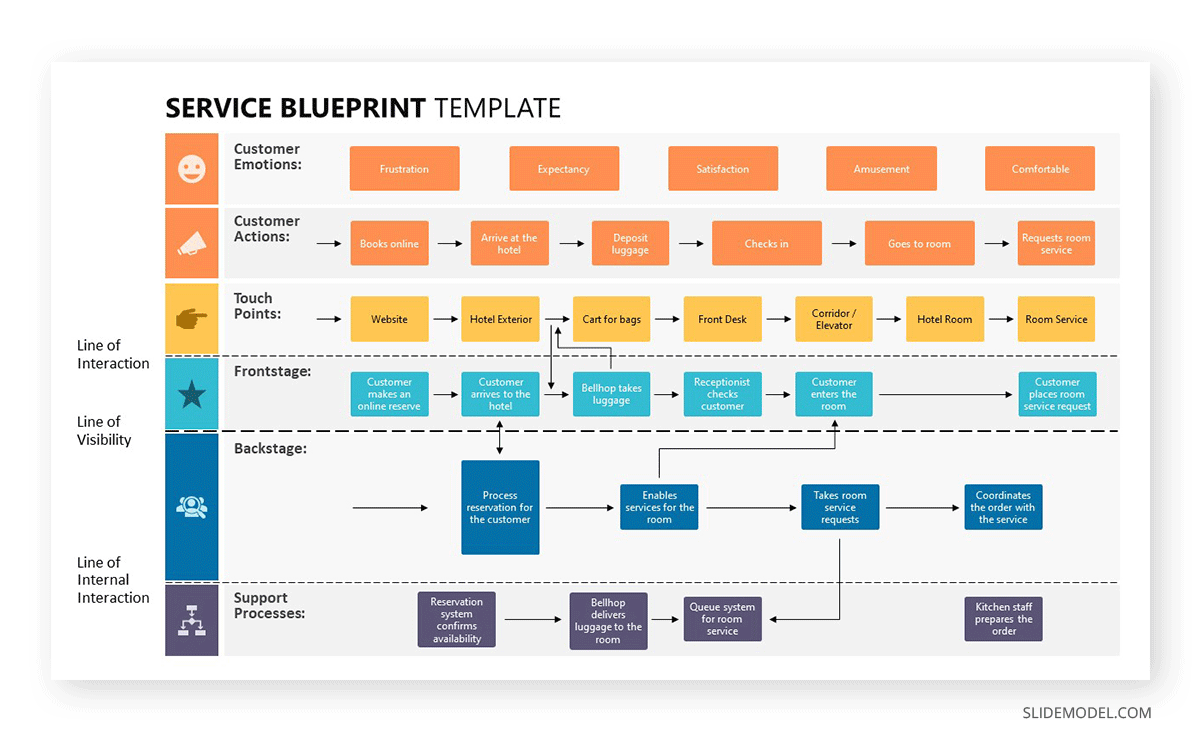
Different Lines in a Service Blueprint
In service blueprinting, three main lines are used to distinguish different elements of the service process and visualize how the elements interact to deliver the final service experience to the customer. These lines include:
The line of interaction: This line represents the point of contact between the customer and the service provider, including all the touchpoints and interactions throughout the service delivery process.
The line of visibility: This line separates the frontstage area, where customers interact directly with the service, from the backstage area, where employees and support processes operate behind the scenes.
The line of internal interaction: This line separates the interactions between the service provider and any internal support processes, such as billing or inventory management, from the interactions involving the customer.
Service Blueprints vs. Flowcharts
Isn’t service blueprinting just the same as flowcharting?
Given that they are both tools for visualizing processes in a business, it’s easy to confuse service blueprints with process documentation flowcharts. But, they are distinct. We can summarize the differences between a service blueprint and a flowchart in three points.
- The primary focus of a service blueprint is on the customer experience, whereas the focus of a flowchart is on the process steps and their sequence.
- Service blueprints are often used for complex service processes that involve multiple touchpoints and interactions, while flowcharts can be used for simple or complex processes.
- A service blueprint provides a holistic view of the service delivery process, including front-stage, backstage, and support activities. A flowchart provides a high-level and linear view of the process, focusing on the main steps and decision points.

Why do companies need a Service Blueprint?
Not every business needs a service blueprint, as it depends on the services’ complexity. However, if you run a large organization, you likely need a service blueprint to ensure a consistent and high-quality service experience for customers.
To appreciate its potential benefits, let’s take a look at the practical application of service blueprinting to a business. Let’s go back to our hotel blueprint example.
The Problem:
For the past week, Hotel A has been receiving complaints from its guests about delayed delivery of room service breakfast. This prompted the hotel manager to form a team that will investigate what aspect of the service delivery process they are doing wrong. The team mapped out the entire process from the customer making the room service request through its completion.
The Findings:
Following the exercise, the team found out that the delay in room service breakfast delivery is due to the unavailability of elevators. A week before the incident, Hotel A decided to shut down some elevators at certain hours of the day for cost-cutting purposes. This forced the room service staff to share elevators with other personnel, therefore causing delays.
The Solution:
Hotel A used these findings to readjust the scheduled elevator shutdowns, so they won’t coincide with the uptick in room service breakfast requests in the morning.
This story summarizes how a business blueprint can benefit any business.
- By mapping out each stage of the customer journey, businesses can identify areas where they can improve the customer experience. This could involve streamlining processes, providing additional resources, or even creating a better customer-brand relationship.
- By mapping out the service process, businesses can identify pain points and bottlenecks leading to customer dissatisfaction. This enables them to proactively improve the service experience and increase customer engagement.
- Lastly, a service blueprint can test how business policies will affect the service delivery outcome. Our example showed how a simple management decision could affect overall customer satisfaction.
How to create a Service Blueprint
Now that we’ve already covered the basics of service blueprinting, its key elements, and its benefits, it’s your turn to implement this concept. In this section, we’ll guide you through the stages of creating a service blueprint for your organization.
Step 1: Define the scope and boundaries of the blueprint
Businesses with several services may need several service blueprints. If that’s your case, identify the specific service process you want to map and set boundaries and limitations to ensure the map remains focused. It’s also important to identify the different people, departments, and systems involved in the said service process.

Step 2: Map the customer journey
Mapping your customer journey involves identifying all the touchpoints and interactions that the customer has with your business. It’s important to involve your customer’s perspective in this process, which can be done through customer interviews, surveys, or observations.
Use visual aids like a flowchart or a diagram to help illustrate the customer journey.
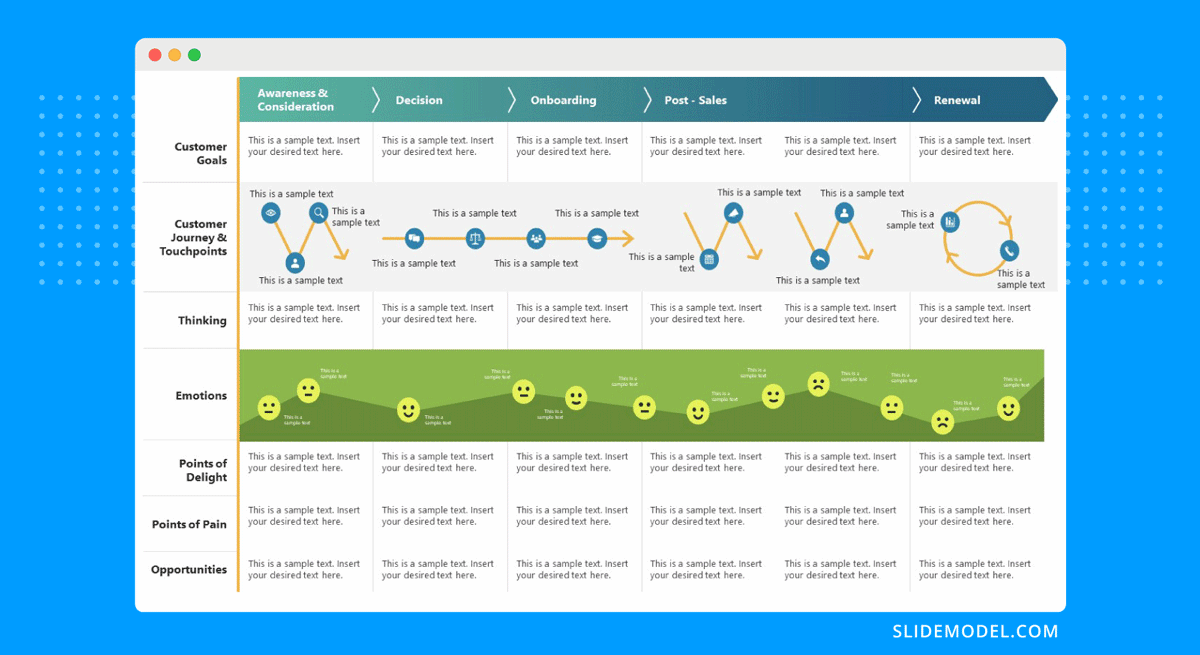
Step 3. Map employee actions
Identify the employee actions required to support each stage of the customer journey. This can include front-line employees who interact directly with customers and back-end employees who work behind the scenes to support the service. Include information on employees’ roles and procedures to ensure the service is delivered consistently.
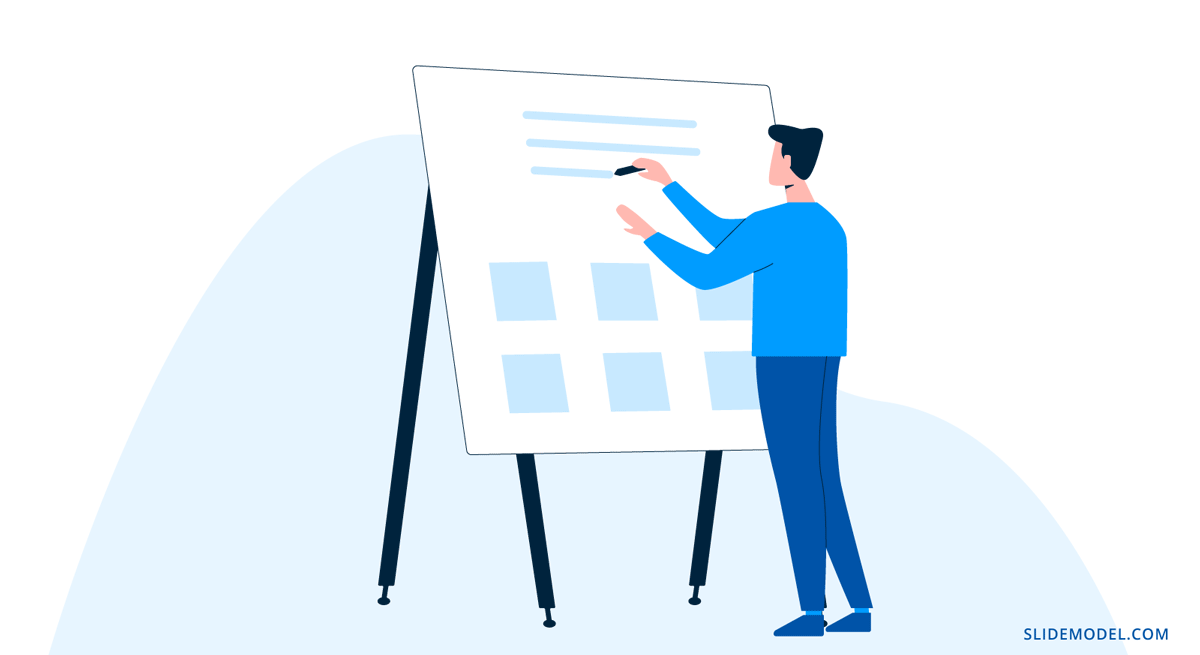
Step 4. Map physical evidence
This step involves identifying and mapping all the tangible elements the customer encounters during their service experience. This includes signage, menus, branding, and other elements that shape customers’ perceptions of the service.

Step 5. Create the Service Blueprint
In this stage, you need to put together the puzzle pieces. Combine the customer journey map, employee actions map, and physical evidence map to create a comprehensive Service Blueprint that illustrates the entire service process. Use visual aids such as color coding or shading to differentiate between blueprint parts.
Step 6. Analyze and improve the blueprint
Once you have completed the service blueprint, it’s important to analyze and evaluate it to identify areas for improvement. This could include identifying gaps in the customer experience, areas where employee actions could be improved, or ways to enhance the physical evidence. Create a plan to implement changes and improvements based on your analysis.
Step 7. Share It
The final step in creating a service blueprint is sharing it with relevant organizational stakeholders, like the employees and managers involved in the service delivery. Doing so can help align everyone involved in the service delivery process.
You can present the service blueprint through PowerPoint at team meetings or include it in employee manuals or training materials.
Final Words
Keeping your customers happy requires getting inside their experience and crafting a service design out of it. Service blueprinting does exactly that and more. It gives you the big picture of the ins and outs of your service delivery process, allowing for its smooth execution. It even allows you to see roadblocks that lie ahead, so you can improve your service experience as needed. A service blueprint might be the one tool you need to gain more returning customers.

